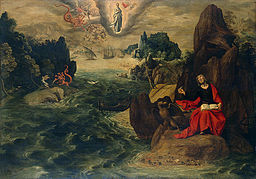 What is a chiasm?
What is a chiasm?
For those who may not be sure what a chiasm is, I will give a brief explanation. A chiasm is a literary structure that one finds in certain parts of the Bible, where the author has arranged a passage in a certain way. This literary structure consists of a certain number of phrases or clauses that build to a central phrase or clause. After the central phrase or clause will come phrases or clauses that run parallel to the initial phrases or clauses. The result is a structure that is often diagrammed with a “v” shape like this:
a
b
c
d
c’
b’
a’
The central element of the chiasm if generally the emphasized element (d). Some think that a secondary emphasis falls upon the first and last elements (a and a’). A chiasm can be rather complex, like John 1:1-18 (see Culpepper article, “Pivot of John’s Prologue”).
Why I believe that the seven letters of Revelation 2-3 are an example of a chiasm:
Interpreters commonly present the seven letters as isolated units with some connections between them. A long time ago, I ran across two observations that have structural implications. First, the Thyatira letter appears to be set apart as the central letter of the series of seven. It is in the central position (fourth), it is the longest letter, and it contains all seven of the common elements of the seven letters. Furthermore, thematically it deals with a major theme of the book, that is, the sin of idolatry or worshiping the Beast. Jezebel is a false teacher, who is charged with deceiving God’s servants (2:20). The other deceivers of the book are the Dragon, the False Prophet, and Babylon the Harlot (12:9; 13:14; 18:23). The second observation is that the Smyrna letter and Philadelphia letter appear to be parallel to one another. Both letters mention testing from “the synagogue of Satan” and neither contains any mention of weakness (2:9; 3:9). These two observations already suggest that a chiastic structure may be present.
Alongside of the chiastic pattern, another pattern is evident as well. The churches with weaknesses are progressing from bad to worse. This is evident in three respects. First, among the paired churches of the chiasm, Ephesus (first) is in better shape than Laodicea (seventh), and Pergamum (third) is in better shape than Sardis (fifth). Second, the first four letters build toward the letter to Thyatira starting with the letter to Ephesus. The Nicolaitans were rejected at Ephesus (2:6), are making inroads at Pergamum (2:15), and Jezebel, a Nicolaitan teacher, has boldly defied Jesus’ prior call to repent at Thyatira (2:21). Third, the letters to Sardis and Laodicea also have certain commonalities, like the emphasis upon white garments and upon being prepared for Jesus’ coming. Sardis is in bad shape, but Laodicea is even worse.
The chiastic structure of the seven letters is important, because it helps to highlight two emphases of the letters. First, the teaching of Jezebel at Thyatira is dangerous and poses a grave threat, which could spread to all of the churches. Her way of compromise is totally unacceptable and worthy of judgment. The churches of Jesus should beware of false teachers whose teaching is like hers. They will be judged along with their followers. Second, the progression from bad to worse means that the two weakest churches (fifth and seventh) occur toward the end of John’s letters. Ending with such low notes tends to emphasize the decline of the churches of Asia Minor. Jesus says nothing good at all about the seventh church. This ending adds emphasis to Jesus’ call for repentance. The church that does not repent of her sins could become like Laodicea, a church with no strengths in the sight of her Lord.
Suggested Resource: Find out about my free Bible study guide to the seven letters by clicking here.
Sources:
These paragraphs are adapted from my book:
Paul Hoskins, The Book of Revelation: A Theological and Exegetical Commentary, pp. 17-18 (those pages provide further sources and footnotes that I have omitted above, as well as a diagram of the chiasm).
